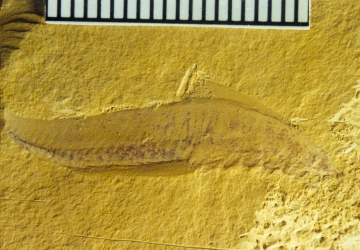680123_Oldest Fish_360 px width.jpg

The Myllokunmingia fossil is evidence of the world's oldest fish and is estimated to be roughly 525 million years old. Credit: Degan Shu, Northwest University, Xi'an, China, Wikimedia.
The Chengjiang formation in China is one of the world’s most important fossil sites. It’s not that big—it covers a couple of square miles in Yunnan province, in the southwestern corner of the country. But it’s a UNESCO World Heritage Site, and an International Geological Heritage Site. That’s because the location has yielded some of the earliest fossils of complex life on Earth—more than 500 million years old. That includes what may be the oldest fish yet seen.
The fish is known as Myllokunmingia fengjiaoa. The only sample was found in rock layers that are roughly 525 million years old. The fossil was only about an inch long and a quarter of an inch tall. But it was so well preserved that scientists could see lots of details, including inside the fish.
The fossil showed a well-defined head—an important feature in the development of life. It also showed fins, gills, and a full digestive system. Those contours revealed that the fish probably was a relative of modern-day lampreys and hagfish, both of which resemble eels.
The Chengjiang site probably consisted of a shallow sea with a muddy bottom. When the fish died, it was covered by a layer of mud that kept it from decomposing, preserving its fossil. That environment also preserved other marine creatures—worms, jellyfish, sponges, and more. That suggests that Myllokunmingia was part of a busy ecosystem—one of the oldest collections of complex life on Earth.

